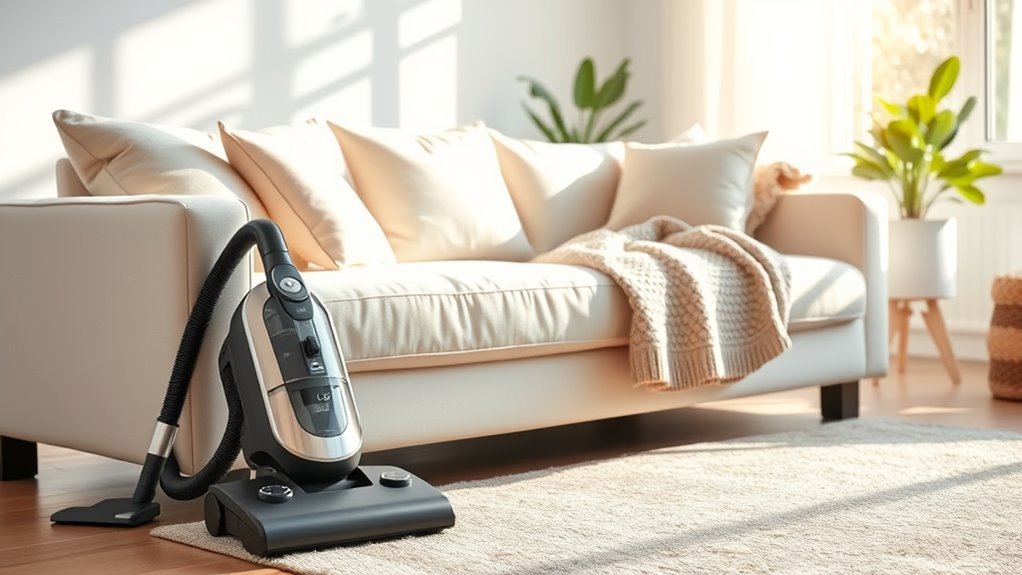Washing Sofa Without Damage
You can wash your sofa without damage by first identifying its fabric type—natural, synthetic, or leather—to choose the right cleaning method. Use gentle upholstery cleaners, a soft brush, and avoid harsh chemicals. Vacuum thoroughly with proper attachments to remove dirt, and spot clean stains using mild solutions suited for their type. Always test cleaners on a hidden area and air dry completely. Want to know how to deep clean while keeping your sofa fresh and intact?
Understanding Different Sofa Fabrics

Before you start cleaning your sofa, it’s important to understand the type of fabric you’re dealing with. Different fabric types require different care instructions to avoid damage. For instance, natural fabrics like cotton and linen can often handle water-based cleaners but may shrink or fade if treated improperly. Synthetic fabrics such as polyester and microfiber are usually more durable and stain-resistant but might need specific solvents. Leather demands gentle products and conditioning to prevent cracking. You’ll find cleaning codes on your sofa’s tag—these letters (W, S, WS, or X) guide you on what cleaning methods are safe. By knowing your sofa’s fabric type and following its care instructions precisely, you free yourself from guesswork and protect your furniture, keeping it fresh without risking damage.
Essential Tools and Cleaning Supplies
To clean your sofa effectively without causing damage, you’ll need a few essential tools and cleaning supplies. Start by gathering your cleaning tools: a vacuum with upholstery attachments, soft microfiber cloths, a soft-bristled brush, and a spray bottle. Your supply checklist should include gentle upholstery cleaner or mild detergent, warm water, and white vinegar for natural cleaning. Avoid harsh chemicals that could strip fabric or cause discoloration. Having a bucket handy helps mix solutions without contamination. These items give you the freedom to tackle dirt and grime safely, preserving your sofa’s texture and color. Being prepared with the right cleaning tools and supplies makes the entire process smoother, so you can enjoy a fresh, damage-free sofa without hassle.
Spot Cleaning Techniques for Common Stains

When you spot a stain on your sofa, the first step is to identify what type it is so you can choose the right cleaning solution. Using gentle methods to apply these solutions helps protect your sofa’s fabric from damage. Let’s explore how to tackle common stains effectively without harming your upholstery.
Identifying Stain Types
How do you know the best way to clean a stain without making it worse? It starts with proper stain classification. Recognizing the type of stain helps you choose the right stain removal method and protects your sofa from damage. Here’s how to identify common stains:
- Water-based stains – Think coffee, juice, or wine. They often look wet and spread easily.
- Oil-based stains – Grease, makeup, or food oils feel greasy and don’t dissolve in water.
- Protein-based stains – Blood, sweat, or dairy products usually have a distinct odor and can set quickly.
Effective Cleaning Solutions
Although identifying the type of stain is essential, knowing the right cleaning solution for each is what truly prevents damage. You want to use eco friendly cleaners that protect both your sofa and the environment. Different stains need different approaches for effective upholstery care.
| Stain Type | Recommended Cleaner |
|---|---|
| Food | Mild dish soap + water |
| Ink | Rubbing alcohol (test first) |
| Oil/Grease | Baking soda + mild detergent |
| Pet Stains | Enzyme-based eco cleaner |
Gentle Application Methods
Apply cleaning solutions with care to avoid damaging your sofa’s fabric. When tackling common stains, you’ll want to use gentle scrubbing paired with soft cloths to preserve the material’s integrity. Here’s how to approach spot cleaning effectively:
- Dampen a soft cloth with your chosen solution, avoiding saturation that can harm the fabric.
- Gently scrub the stained area in circular motions, loosening dirt without stressing fibers.
- Blot the spot with a dry cloth to absorb moisture and prevent watermarks.
How to Vacuum Your Sofa Properly

To vacuum your sofa without causing damage, start by choosing the right attachment, like a brush or upholstery tool. Work in sections to guarantee you cover the entire surface thoroughly. This approach helps remove dust and debris effectively while protecting the fabric.
Choose the Right Attachment
One of the most important steps in vacuuming your sofa properly is choosing the right attachment. Different attachment types offer various benefits that help you clean without damaging your sofa’s fabric or structure. Picking the right tool frees you from worries about wear and tear, letting you enjoy a fresh, clean sofa effortlessly.
Here are three common attachment types and their benefits:
- Brush Attachment – Gently lifts dirt from delicate fabrics without scratching.
- Crevice Tool – Reaches tight corners and seams where dust hides.
- Upholstery Nozzle – Provides wide coverage for quick, effective cleaning on larger areas.
Using the right attachment maximizes efficiency and keeps your sofa looking its best, giving you freedom from dirt and hassle.
Vacuum in Sections
After picking the right attachment, you’ll want to tackle your sofa methodically by vacuuming it in sections. Start with one armrest, moving the vacuum slowly to let the suction power lift dirt without damaging the fabric. Breaking the task into parts helps you focus on every inch, ensuring thorough upholstery care. Don’t rush; gentle, steady strokes prevent wear and keep your sofa looking fresh. Pay special attention to crevices where crumbs hide, using a narrow nozzle if needed. By working this way, you maintain control and protect your sofa’s material, giving yourself the freedom to enjoy a clean, comfortable space without worry. Vacuuming in sections isn’t just efficient—it’s the smart approach to preserving your sofa’s life.
Using Homemade Cleaning Solutions Safely
Although homemade cleaning solutions can be effective and economical, you’ll need to use them carefully to avoid damaging your sofa. When you choose homemade cleaners for sofa maintenance, remember that natural doesn’t always mean harmless. Test your solution first to protect your freedom from costly mistakes. Here’s how to use them safely:
- Spot test on a hidden area to check for colorfastness and fabric reaction.
- Apply with a soft cloth, gently blotting instead of rubbing to avoid fabric wear.
- Use minimal solution and allow the sofa to air dry completely to prevent mold.
Deep Cleaning Methods That Protect Your Sofa
While homemade solutions work well for regular upkeep, you’ll want to take extra care with deep cleaning to truly protect your sofa’s fabric and structure. Deep cleaning shouldn’t be too frequent—overdoing it can wear down fibers. Aim for a cleaning frequency of every six to twelve months, depending on use. When you deep clean, use gentle, fabric-specific products or professional steam cleaning to avoid damage. Always test any cleaner on a hidden spot first. Protecting your sofa’s fabric means avoiding harsh chemicals and excessive moisture. By balancing regular light cleaning with thoughtful deep cleans, you keep your sofa fresh and durable without sacrificing its look or feel. This approach gives you the freedom to enjoy your space without worrying about premature wear.
Tips for Drying and Maintaining Freshness
Three key steps will help you dry your sofa properly and keep it smelling fresh. Mastering the right drying techniques guarantees sofa freshness without restricting your living space.
- Ventilate well – Open windows or use fans to speed up air circulation, preventing dampness and musty odors.
- Avoid direct heat – Stay clear of heaters or direct sunlight; they can damage fabric and cause shrinking.
- Fluff cushions regularly – While drying, fluff and rotate cushions to promote even air flow and keep the sofa plump.
Frequently Asked Questions
Can I Use a Steam Cleaner on All Sofa Types?
You can’t use a steam cleaner on all sofa types because fabric compatibility varies. While steam cleaner effectiveness is great on durable materials like cotton or polyester, delicate fabrics like silk or velvet might get damaged. So, you’ll want to check your sofa’s care label first. Choosing the right method lets you clean freely without risking damage, keeping your space fresh and comfy without restrictions.
How Often Should Professional Sofa Cleaning Be Scheduled?
For fabulous freshness, frequent professional cleaning is key! Scheduling frequency usually depends on your sofa’s use and fabric, but aiming for every 12 to 18 months keeps things crisp. Regular renewal releases dirt and allergens, boosting your comfort and extending your sofa’s lifespan. You’ll feel freer knowing your space stays spotless, and the cleaning benefits mean less hassle and more time to enjoy your living area without worry or work.
Are There Any Fabrics That Should Never Be Wet Cleaned?
You should avoid wet cleaning on delicate fabrics like silk, velvet, and some wool upholstery materials, as water can cause shrinkage, color bleeding, or texture damage. If you want to keep your freedom to enjoy your furniture without risking harm, it’s best to check the fabric care label or consult a professional. Dry cleaning or spot cleaning methods often work better for these sensitive materials, ensuring your upholstery stays vibrant and intact.
Can Sofa Cushions Be Machine Washed Safely?
Imagine your sofa cushions as fluffy clouds—tempting to toss into the washing machine for a fresh start. But when it comes to cushion care, you need to be cautious. Some cushions can handle machine washing, but many can’t without risking damage. Always check the care label first. For safe washing tips, spot cleaning or gentle hand washing often lets you keep that freedom to refresh without shrinking or warping your cozy clouds.
How Do I Remove Pet Odors Without Damaging Fabric?
To remove pet odors without damaging fabric, sprinkle baking soda liberally over your sofa and let it sit for a few hours to absorb smells. Then, gently vacuum it up. For tougher odors, mix a vinegar solution—equal parts water and white vinegar—and lightly mist the fabric. Don’t soak it. This natural method freshens your space without harsh chemicals, giving you freedom from pet smells while keeping your sofa safe and comfy.






